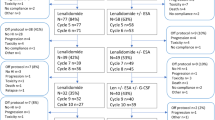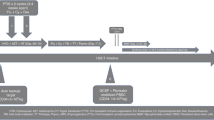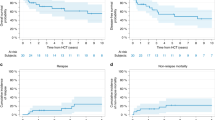Abstract
After failure of erythropoiesis-stimulating agents (ESAs), lenalidomide (LEN) yields red blood cell (RBC) transfusion independence (TI) in 20–30% of lower-risk non-del5q myelodysplastic syndrome (MDS). Several observations suggest an additive effect of ESA and LEN in this situation. We performed a randomized phase III study in 131 RBC transfusion-dependent (TD, median transfusion requirement six RBC units per 8 weeks) lower-risk ESA-refractory non-del5q MDS. Patients received LEN alone, 10 mg per day, 21 days per 4 weeks (L arm) or LEN (same schedule) + erythropoietin (EPO) beta, 60,000 U per week (LE arm). In an intent-to-treat (ITT) analysis, erythroid response (HI-E, IWG 2006 criteria) after four treatment cycles (primary end point) was 23.1% (95% CI 13.5–35.2) in the L arm and 39.4% (95% CI 27.6–52.2) in the LE arm (P=0.044), while RBC-TI was reached in 13.8 and 24.2% of the patients in the L and LE arms, respectively (P=0.13). Median response duration was 18.1 and 15.1 months in the L and LE arms, respectively (P=0.47). Side effects were moderate and similar in the two arms. Low baseline serum EPO level and a G polymorphism of CRBN gene predicted HI-E. Combining LEN and EPO significantly improves erythroid response over LEN alone in lower-risk non-del5q MDS patients with anemia resistant to ESA.
This is a preview of subscription content, access via your institution
Access options
Subscribe to this journal
Receive 12 print issues and online access
$259.00 per year
only $21.58 per issue
Buy this article
- Purchase on Springer Link
- Instant access to full article PDF
Prices may be subject to local taxes which are calculated during checkout




Similar content being viewed by others
References
Ades L, Itzykson R, Fenaux P . Myelodysplastic syndromes. Lancet 2014; 383: 2239–2252.
Greenberg P, Cox C, LeBeau MM, Fenaux P, Morel P, Sanz G et al. International scoring system for evaluating prognosis in myelodysplastic syndromes. Blood 1997; 89: 2079–2088.
Greenberg PL, Tuechler H, Schanz J, Sanz G, Garcia-Manero G, Sole F et al. Revised international prognostic scoring system for myelodysplastic syndromes. Blood 2012; 120: 2454–2465.
Hellstrom-Lindberg E, Ahlgren T, Beguin Y, Carlsson M, Carneskog J, Dahl IM et al. Treatment of anemia in myelodysplastic syndromes with granulocyte colony-stimulating factor plus erythropoietin: results from a randomized phase II study and long-term follow-up of 71 patients. Blood 1998; 92: 68–75.
Casadevall N, Durieux P, Dubois S, Hemery F, Lepage E, Quarre MC et al. Health, economic, and quality-of-life effects of erythropoietin and granulocyte colony-stimulating factor for the treatment of myelodysplastic syndromes: a randomized, controlled trial. Blood 2004; 104: 321–327.
Park S, Grabar S, Kelaidi C, Beyne-Rauzy O, Picard F, Bardet V et al. Predictive factors of response and survival in myelodysplastic syndrome treated with erythropoietin and G-CSF: the GFM experience. Blood 2008; 111: 574–582.
Jadersten M, Malcovati L, Dybedal I, Della Porta MG, Invernizzi R, Montgomery SM et al. Erythropoietin and granulocyte-colony stimulating factor treatment associated with improved survival in myelodysplastic syndrome. J Clin Oncol 2008; 26: 3607–3613.
Greenberg PL, Sun Z, Miller KB, Bennett JM, Tallman MS, Dewald G et al. Treatment of myelodysplastic syndrome patients with erythropoietin with or without granulocyte colony-stimulating factor: results of a prospective randomized phase 3 trial by the Eastern Cooperative Oncology Group (E1996). Blood 2009; 114: 2393–2400.
Sekeres MA, Steensma DP . Defining prior therapy in myelodysplastic syndromes and criteria for relapsed and refractory disease: implications for clinical trial design and enrollment. Blood 2009; 114: 2575–2580.
Corral LG, Haslett PA, Muller GW, Chen R, Wong LM, Ocampo CJ et al. Differential cytokine modulation and T cell activation by two distinct classes of thalidomide analogues that are potent inhibitors of TNF-alpha. J Immunol 1999; 163: 380–386.
List A, Kurtin S, Roe DJ, Buresh A, Mahadevan D, Fuchs D et al. Efficacy of lenalidomide in myelodysplastic syndromes. N Engl J Med 2005; 352: 549–557.
List A, Dewald G, Bennett J, Giagounidis A, Raza A, Feldman E et al. Lenalidomide in the myelodysplastic syndrome with chromosome 5q deletion. N Engl J Med 2006; 355: 1456–1465.
Raza A, Reeves JA, Feldman EJ, Dewald GW, Bennett JM, Deeg HJ et al. Phase 2 study of lenalidomide in transfusion-dependent, low-risk, and intermediate-1 risk myelodysplastic syndromes with karyotypes other than deletion 5q. Blood 2008; 111: 86–93.
Sibon D, Cannas G, Baracco F, Prebet T, Vey N, Banos A et al. Lenalidomide in lower-risk myelodysplastic syndromes with karyotypes other than deletion 5q and refractory to erythropoiesis-stimulating agents. Br J Haematol 2012; 156: 619–625.
Komrokji RS, Garcia-Manero G, Ades L, Laadem A, Vo B, Prebet T et alAn open-label, phase 2, dose-finding study of sotatercept (ACE-011) in patients with low or intermediate-1 (Int-1)-risk myelodysplastic syndromes (MDS) or non-proliferative chronic myelomonocytic leukemia (CMML) and anemia requiring transfusion. ASH Annual Meeting Abstracts, 2014; abstract 3251.
Vardiman JW, Thiele J, Arber DA, Brunning RD, Borowitz MJ, Porwit A et al. The 2008 revision of the World Health Organization (WHO) classification of myeloid neoplasms and acute leukemia: rationale and important changes. Blood 2009; 114: 937–951.
Malcovati L, Hellstrom-Lindberg E, Bowen D, Ades L, Cermak J, Del Canizo C et al. Diagnosis and treatment of primary myelodysplastic syndromes in adults: recommendations from the European LeukemiaNet. Blood 2013; 122: 2943–2964.
Cheson BD, Greenberg PL, Bennett JM, Lowenberg B, Wijermans PW, Nimer SD et al. Clinical application and proposal for modification of the International Working Group (IWG) response criteria in myelodysplasia. Blood 2006; 108: 419–425.
Sardnal V, Rouquette A, Kaltenbach S, Bally C, Chesnais V, Leschi C et al. A G polymorphism in the CRBN gene acts as a biomarker of response to treatment with lenalidomide in low/int-1 risk MDS without del(5q). Leukemia 2013; 27: 1610–1613.
Gail M, Simon R . Testing for qualitative interactions between treatment effects and patient subsets. Biometrics 1985; 41: 361–372.
Fenaux P, Haase D, Sanz GF, Santini V, Buske C, ESMO Guidelines Working Group. Myelodysplastic syndromes: ESMO Clinical Practice Guidelines for diagnosis, treatment and follow-up. Ann Oncol 2014; 25: iii57–iii69.
Narla A, Dutt S, McAuley JR, Al-Shahrour F, Hurst S, McConkey M et al. Dexamethasone and lenalidomide have distinct functional effects on erythropoiesis. Blood 2011; 118: 2296–2304.
Fink EC, Krönke J, Hurst SN, Udeshi ND, Svinkina T, Schneider RK et alLenalidomide induces ubiquitination and degradation of CSNK1A1 in MDS with Del(5q). ASH Annual Meeting Abstracts, 2014; 124, abstract 4.
List A, Estes M, Gao G, Janokowska A, Maciejewski J Large CD45 protein tyrosine phosphatase (PTP) isoforms predominate in myelodysplastic erythroid precursors and attenuate the erythropoietin (EPO): STAT5 signal. ASH Annual Meeting Abstracts, 2006; 108, abstract 2650.
McGraw KL, Basiorka AA, Johnson JO, Clark J, Caceres G, Padron E et al. Lenalidomide induces lipid raft assembly to enhance erythropoietin receptor signaling in myelodysplastic syndrome progenitors. PLoS One 2014; 9: e114249.
Komrokji RS, Lancet JE, Swern AS, Chen N, Paleveda J, Lush R et al. Combined treatment with lenalidomide and epoetin alfa in lower-risk patients with myelodysplastic syndrome. Blood 2012; 120: 3419–3424.
Wei S, Chen X, Rocha K, Epling-Burnette PK, Djeu JY, Liu Q et al. A critical role for phosphatase haplodeficiency in the selective suppression of deletion 5q MDS by lenalidomide. Proc Natl Acad Sci USA 2009; 106: 12974–12979.
Giagounidis A, Fenaux P, Mufti GJ, Muus P, Platzbecker U, Sanz G et al. Practical recommendations on the use of lenalidomide in the management of myelodysplastic syndromes. Ann Hematol 2008; 87: 345–352.
Thepot S, Abdelali RB, Chevret S, Renneville A, Rauzy OB, Prebet T et alPrognostic factors of response and survival to azacitidine (AZA) +/− EPO in RBC transfusion dependent (TD) IPSS low and Int-1 (LR) MDS resistant to EPO, with particular emphasis of genetic lesions: a study by the GFM. ASH Annual Meeting Abstracts, 2013; abstract 658.
Tobiasson M, Dybedahl I, Holm MS, Karimi M, Brandefors L, Garelius H et al. Limited clinical efficacy of azacitidine in transfusion-dependent, growth factor-resistant, low- and Int-1-risk MDS: results from the nordic NMDSG08A phase II trial. Blood Cancer J 2014; 4: e189.
Sloand EM, Wu CO, Greenberg P, Young N, Barrett J . Factors affecting response and survival in patients with myelodysplasia treated with immunosuppressive therapy. J Clin Oncol 2008; 26: 2505–2511.
Sloand EM, Olnes MJ, Shenoy A, Weinstein B, Boss C, Loeliger K et al. Alemtuzumab treatment of intermediate-1 myelodysplasia patients is associated with sustained improvement in blood counts and cytogenetic remissions. J Clin Oncol 2010; 28: 5166–5173.
Raza A, Galili N, Smith SE, Godwin J, Boccia RV, Myint H et al. A phase 2 randomized multicenter study of 2 extended dosing schedules of oral ezatiostat in low to intermediate-1 risk myelodysplastic syndrome. Cancer 2012; 118: 2138–2147.
Garcia-Manero G, Khoury HJ, Jabbour E, Lancet J, Winski SL, Cable L et al. A phase I study of oral ARRY-614, a p38 MAPK/Tie2 dual inhibitor, in patients with low or intermediate-1 risk myelodysplastic syndromes. Clin Cancer Res 2015; 21: 985–994.
Platzbecker U, Germing U, Giagounidis A, Goetze K, Kiewe P, Mayer K et alACE-536 increases hemoglobin and reduces transfusion burden in patients with low or intermediate-1 risk myelodysplastic syndromes (MDS): preliminary results from a phase 2 study. ASH Annual Meeting Abstracts, 2014; abstract 411.
Acknowledgements
We thank Fatiha Chermat and Rosa Sapena from the Groupe Francophone des Myelodysplasies (GFM) for the management, logistical and administrative assistance. This research was supported by Celgene (Summit, NJ) and Roche (Basel, Switzerland) who provided lenalidomide and epoetin beta, respectively, along with a research grant. PF received honoraria and research funding from Celgene Corporation. FD received honoraria from Celgene and Novartis.
Author contributions
AT performed clinical research, analyzed data and wrote the paper. OK performed biological research and wrote the paper. SChev analyzed data and wrote the paper. AR, JD, AS, CR, OB-R, AB, AG-B, SW, DC, KL, BDR, DB, CG, BS, LS, VS, RP, BG, PCM, BC, CSa, RB, LL, EW, GT, KB, FG, ALT, SChez, KM, SN, CSo, FI, EG and CP performed research and wrote the paper. MF, PF and FD designed research, analyzed data and wrote the paper.
Author information
Authors and Affiliations
Corresponding author
Ethics declarations
Competing interests
The authors declare no conflict of interest.
Rights and permissions
About this article
Cite this article
Toma, A., Kosmider, O., Chevret, S. et al. Lenalidomide with or without erythropoietin in transfusion-dependent erythropoiesis-stimulating agent-refractory lower-risk MDS without 5q deletion. Leukemia 30, 897–905 (2016). https://doi.org/10.1038/leu.2015.296
Received:
Revised:
Accepted:
Published:
Issue Date:
DOI: https://doi.org/10.1038/leu.2015.296
This article is cited by
-
Combining lenalidomide with erythropoiesis stimulating agents: a party of one
Leukemia (2024)
-
Determinants of lenalidomide response with or without erythropoiesis-stimulating agents in myelodysplastic syndromes: the HOVON89 trial
Leukemia (2024)
-
Current Therapeutic Landscape in Lower Risk Myelodysplastic Syndromes
Current Treatment Options in Oncology (2023)
-
Management of patients with lower-risk myelodysplastic syndromes
Blood Cancer Journal (2022)
-
Isolated duodenal ischemia of unknown etiology: a case report
BMC Surgery (2021)



